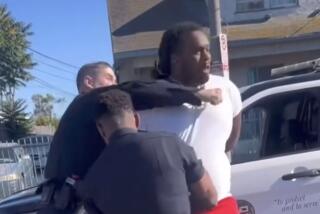Papers Describe Agency’s Morale Troubles
- Share via
New details about the depth and causes of some firefighters’ dissatisfaction with the Los Angeles Fire Department emerged Tuesday, contained in voluminous supporting documents for an audit released earlier this month.
The documents show that, though the department has greatly improved the ethnic diversity of its rank and file, morale among some groups is low. A generation gap at stationhouses and confusing regulations are contributing to the dissatisfaction, the documents reveal.
The audit, commissioned by City Controller Laura Chick, found substantial numbers of minorities -- especially blacks -- and women saying they had either experienced or were aware of discrimination within the department.
Auditors sent the survey to all minorities and women in the department’s firefighting ranks and to new recruits, regardless of ethnicity. Slightly less than half of those contacted completed the survey.
Among those responding, 87% of African Americans reported discrimination, as did 80% of women.
The hiring and retention of women was the one area in which the department’s staffing had not improved in the last decade, the audit found.
In 1995, women made up 2.9% of the department’s firefighters; in 2005, that number had slipped to 2.7%.
In the same period, the percentage of minorities in the department’s rank and file increased from 39.5% to 47%.
Chief William Bamattre said in an interview Tuesday that there were complex cultural changes involving age and education that have more to do with a generation gap than with race.
“My feeling is 10 years ago, we had issues and many were race-based and ethnicity-based,” he said. “We’ve hired 1,100 new employees, and while recognizing it’s more diversified ethnically and racially, I don’t think that’s at the root. It’s that we have 1,100 new employees and four different generations and value systems that are causing problems. It’s the inability of people to get along in the fire stations.”
Older firefighters complained about younger ones to the auditors.
“We hear from older managers that it is their perception the new generation of workers, particularly the well-educated Generation X, do not have the same commitment and dedication to the Fire Department,” the auditors wrote in background papers. “Specifically, the new generation does not take orders without questioning the reasoning behind the order.”
The gap showed up in other ways as well. Veterans were more likely to say they had hazed someone, with 65% of those with more than 10 years in the department, saying they had. Rookies were the least likely to have reported engaging in the practice.
The auditors also found, however, that the top brass adds to the sense of confusion about expected behavior by issuing convoluted rules and regulations.
For example, department policy requires three people to operate a 35-foot ladder, including during training. But because only two people are available in many emergency situations, many stations were practicing ladder maneuvers with two people instead of three.
A clarification stressed that the 35-foot ladder was to be operated by three people at all times. But the statement went on to permit 35-foot ladder practice with two people under direct supervision and with assistant firefighters on either side to help.
“This policy clarification is at the same time contradictory and seemingly inconsistent with department policy,” auditors wrote.
More to Read
Sign up for Essential California
The most important California stories and recommendations in your inbox every morning.
You may occasionally receive promotional content from the Los Angeles Times.










